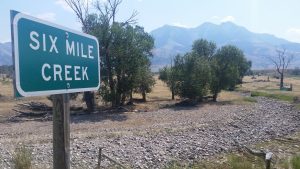
Stream dried up for irrigation of livestock forage. Photo by George Wuerthner
Recently the Greater Yellowstone Coalition (GYC) announced they were working to reduce the wildlife impacts of fences. Not by removing the fences, but by changing the wire on them to facilitate easier wildlife passage. Fences, as GYC, noted hinder wildlife migrations, and in particular, are a barrier to pronghorn which are reluctant to jump a fence.
Ordinarily, I would praise this effort, especially if part of a broader strategy to remove the single biggest environmental problem in the Greater Yellowstone Ecosystem (GYE)—namely livestock production.
Back when I worked for the organization in the early 1990s, we talked a lot about cumulative impacts—or the collective environmental degradation of a thousand cuts. You won’t hear GYC talking about cumulative effects, and you won’t see many references to science either. Both are too controversial and would harm their fundraising efforts.
Advocating for better fences is non-controversial. Who isn’t for this? But in the big picture, it will make little difference to the region’s wildlife. That is why GYC supports it. It’s an easy win. The harder work is to educate the public about the multiple ways that livestock production harms the GYE.
What you won’t hear from GYC is that fences, even “wildlife-friendly” fences, still harm many wildlife species. For instance, fence collisions are responsible for up to 30% mortality in sage grouse. And fence poles are used as lookout posts by avian predators like golden eagles which prey on sage grouse.
But that is only the beginning of the litany of livestock impacts on the ecosystem that GYC ignores. Indeed, just about every species that GYC professes to care about are harmed by the livestock industry. Species impacted include bison to grizzly bears to cutthroat trout to sage grouse and wolves.
The root of nearly all environmental impacts and ecosystem degradation in the GYE is a consequence of livestock production.
Livestock is the reason we are shooting bison that wander from Yellowstone.
The slaughter of wolves, grizzlies, and coyotes throughout the ecosystem is to appease the livestock industry. Nor will you hear them mention that even the presence of livestock displaces native herbivores like elk, not to mention that domestic animals are consuming the forage that would support native wildlife like elk, and other ungulates. All this affects the prey for larger predators. Instead, you’ll hear a lot of hype about “predator friendly” ranchers.
Irrigated livestock forage is responsible for the degradation of the GYE aquatic ecosystems. Livestock is also the biggest source of water pollution throughout the ecosystem. The most significant cause of riparian area ( the green strips of vegetation along streams) destruction is due to trampling by livestock.
The spread of weeds like cheatgrass, which is responsible for range fires, is primarily due to the destruction of soil crusts by livestock, which in turn promotes cheatgrass establishment and spread. Many other species from frogs to snails to prairie dogs to grasshoppers are killed to satisfy the livestock industry.
Livestock is the source of diseases that are a threat to native wildlife from pneumonia that harms bighorn sheep to Chronic Wasting Disease that originally came from domestic livestock.
No, you won’t hear any of this from GYC even though they have a five million dollar budget and certainly could learn these facts if they had any interest in really protecting and enhancing the ecosystem.
GYC has never questioned grazing privileges on public lands. You won’t hear them asking why public wildlife like wolves and grizzlies are killed to subsidize the private profit of ranchers.
The reason GYC has never gone after the root of the problem, instead of promotes “feel good” projects like developing wildlife-friendly fences and bear-proof garbage cans, is simple. Money. Long ago, GYC decided to invite wealthy ranchers on its board of directors. GYC has gone out of its way to avoid hiring anyone with any knowledge of the real impacts of livestock production. Indeed, it barely relies on science for anything anymore.
Their halfway livestock policies will never make much difference in the big picture. It is analogous to a group like the American Medical Association promoting filtered cigarettes under the guise of reducing lung cancer, instead of challenging the tobacco industry itself.
I would like to write something positive about GYC but they don’t give me much to work with these days. Real conservation requires challenging the status quo. If the status quo were working there would be no need for conservation.
GYC is unwilling to ruffle any feathers and in some instances, actually provides greenwashing to destructive activities and policies. I truly believe the ecosystem would be better off if GYC just disappeared.
If you are a member of GYC because you think they are working to protect the Greater Yellowstone Ecosystem, think again. They are primarily working to protect themselves and their funding.